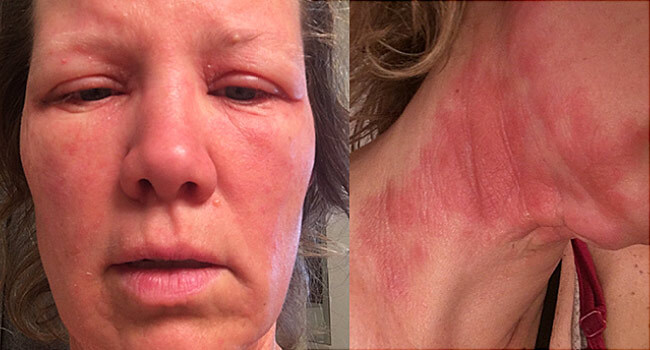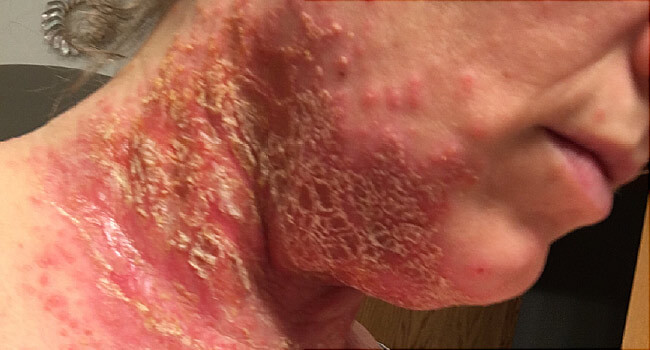Every morning, she placed frankincense oil, which many people say is an immune increaser, under her tongue. If her head hurt, she dabbed calming peppermint oil on her temples. Through the night, she massaged the underside of her feet with grapefruit oil, often invoiced as an appetite suppressor. By day, she lathered her arms with antibacterial bergamot oil and dropped fragrant lemon oil into her detergent and water bottle.
Then one night after sitting in the sun at a baseball game, she spotted a rash on her neck and arms. By morning, her eyes were swollen shut and the oozing welts on her neck burned. The rash cleared. But for weeks, each time the sun hit her skin even briefly, it returned. Ultimately, it got so gruesome that doctors had to inject her with steroids. The suspected culprit: A toxic reaction to essential oils.
“I admit I was probably overusing them,” says the 44-year-old mother of five from Omaha, NE. “But I don’t think people are aware that even though they’re natural products, they can do real damage.”

Those distributors, and more demand for over-the counter “natural” remedies free of the side effects that can come with prescription drugs, has fueled a surge in essential oils demand.
But as their DIY use explodes, concerns abound.
“There is definitely credible science behind certain benefits for certain essential oils,” says Cynthia Bailey, MD, a dermatologist in Sebastopol, CA. “But you have to choose wisely, and you cannot use them indiscriminately.”

How Essential Oils Work
As far back as 1,000 A.D., healers used mechanical presses or steam to extract essential oils from aromatic plants. Today, practitioners can rub oil-infused lotions on the skin, where the compounds are absorbed into the bloodstream. Or they can diffuse them into the air where, once inhaled, they bind to smell receptors and stimulate the central nervous system, says Joie Power, PhD, a neuropsychologist and aromatherapist who has taught nurses how to use the oils for decades.
Research behind them remains fairly scarce, with scientists only recently using controlled human trials. But thanks to a growing number of studies showing how they work, the oils are being used more in hospitals and clinics for stress relief, pain and nausea relief, and even to prevent bedsores.
One recent study of 300 patients found that those who breathed a mixture of ginger, spearmint, peppermint, and cardamom suffered much less nausea after surgery. Others have shown that lavender oil can lower levels of the stress hormone cortisol, and inhaling lemongrass aroma before a stressful event can prevent anxiety. Studies also show that tea tree and oregano oils can fight microbes, making them popular treatments for dandruff and toe fungus. Others can be used as an anti-inflammatory.
In 2014, the FDA sent warning letters to two direct-selling companies — doTERRA and Young Living — for making unsubstantiated claims that their oils could treat everything from herpes to Ebola.
There is so much misinformation out there right now, it really concerns me.
– Joie Power, PhD
Meanwhile, ill-informed at-home users tend to misuse them. One group of concerned aromatherapists began collecting injury reports online. Since the fall of 2013, it has received 229, ranging from mild rashes and anaphylactic shock to internal chemical burns from using oils to treat vaginal yeast infections.
“Essential oils are very safe and effective if used properly for addressing routine health challenges. But there is so much misinformation out there right now, it really concerns me,” Power says.
What Not to Do
Contrary to what several essential oil companies recommend, the oils generally should not be swallowed, Power says. The body absorbs more this way, boosting the chance that they will interact with medications or cause an allergic or toxic reaction. Even continued exposure to small amounts (a few drops a day in a water bottle) can lead to fatigue and headaches. Taking in larger amounts of certain oils — like tea tree oil, wintergreen, and camphor — can lead to throat swelling, a racing heart, vomiting, and even seizures, says the Tennessee Poison Center, which saw the number of toxic essential oil exposures double from 2011 to 2015.
“I would certainly advise teens and children not to use essential oils,” says Jessica Krant, MD, an assistant clinical professor of dermatology at SUNY Downstate Medical Center in New York.

For pregnant women, even oils used on your skin can cross the placental barrier and impact an unborn baby. And swallowing some rare oils, including pennyroyal, can lead to miscarriage. The safest bet during pregnancy: Work with a professional who knows how to use them or skip them altogether, Power says.
I would certainly advise teens and children not to use essential oils.
– Jessica Krant, MD
The company added: “doTERRA labels its products to help customers avoid any potential issues, no matter how rare, and provides a great deal of education on our website.”
Dermatologists say they frequently see patients who have contact reactions, including large blisters, after putting 100% essential oils directly onto their skin.
Allergic reactions are also common. Bailey has seen rashes on eyelids from essential oil droplets emitted by diffusers and around mouths from peppermint oil-infused mouthwash or lip balm.
Overuse can also lead to an allergy over time, Bailey says. (That’s likely what happened to Armstrong, who still can’t go anywhere near lemon without breaking out in hives.)
“Once you become sensitized, you will forever be allergic to it,” Bailey says.
Because the FDA does not test oils for how well they work and safety before they’re sold, it’s critical for consumers to go with a trusted brand. Consumers can report bad reactions to the agency.
With all these risks involved, are they still worth a try?
Absolutely, say doctors and aromatherapists. Just do your homework first.
Pick up a book outlining the different oils, their risks and benefits, and always read the fine print on the bottle and on the pamphlet. And, as Armstrong cautions, don’t take too much comfort in the term “natural.”
Sources
Sources
Rachael Armstrong, consumer.
Cynthia Bailey, MD, dermatologist, Sebastopol, CA.
Jessica Krant, MD, assistant clinical professor of dermatology, SUNY Downstate Medical Center, New York City.
Joie Power, PhD, clinical aromatherapy consultant and neuropsychologist, Asheville, NC.
SPINS, market research firm, Schaumburg, IL.
 Freshsein
Freshsein